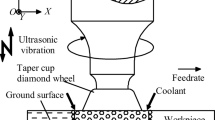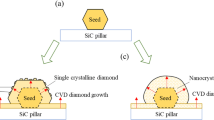Abstract
Grinding has become one of the most efficient precision machining methods to treat with undesired machining defects and improve the surface integrity for the hard and brittle engineering ceramics. However, it is inevitable to cause micro-damages and related transformation of microscopic features, which will eventually affect the grinding quality. This paper is devoted to investigate the high-speed grinding microscopic features of silicon carbide ceramics to reveal the application of high-speed grinding technique in precision machining of ceramics. A comparative study of high-speed and conventional speed grinding of silicon carbide ceramics is discussed in terms of phase transformation, residual stresses, micro-damages, grinding chips, and surface topography. The results show that the high-speed grinding (HSG) process could help substantially improve the workpiece integrity in terms of better surface finish, smaller damages, and controlled residual stresses with a higher material removal rate. Moreover, it has also been proved that a polytypic phase transformation could be induced in HSG process.
Similar content being viewed by others
References
Liew PJ, Yan J, Kuriyagawa T (2013) Carbon nanofiber assisted micro electro discharge machining of reaction-bonded silicon carbide. J Mater Process Technol 213(7):1076–1087
Wang CC, Fang QH, Chen JB, Liu YW, Jin T (2016) Subsurface damage in high-speed grinding of brittle materials considering kinematic characteristics of the grinding process. Int J Adv Manuf Technol 83:937–948
Jiang JL, Ge PQ, Bi WB, Zhang L, Wang DX, Zhang Y (2013) 2D/3D ground surface topography modeling considering dressing and wear effects in grinding process. Int J Mach Tool Manu 74:29–40
Simanchal K, Bandyopadhyay PP, Paul S (2017) High speed and precision grinding of plasma sprayed oxide ceramic coatings. Ceram Int 43:15316–15331
Wang DX, Ge PQ, Bi WB, Jiang JL (2014) Grain trajectory and grain workpiece contact analyses for modeling of grinding force and energy partition. Int J Adv Manuf Technol 70:2111–2123
Wu CJ, Li BZ, Yang JG, Liang SY (2016) Prediction of grinding force for brittle materials considering co-existing of ductility and brittleness. Int J Adv Manuf Technol 87:1967–1975
Zhang QL, To S, Zhao QL, Guo B (2016) Surface generation mechanism of WC/Co and RB-SiC/Si composites under high spindle speed grinding (HSSG). Int. J Refract Met H Mater 56:123–131
Zhu YQ, Sekine T, Kobayashi T, Takazawa E (1998) Shock-induced phase transitions among SiC polytypes. J Mater Sci 33(24):5883–5890
Lu YP, He DW, Zhu J, Yang XD (2008) First-principles study of pressure-induced phase transition in silicon carbide. Physica B 403(19–20):3543–3546
Dompoint D, Boulle A, Sandulache G, Chaussende D, Hoa LTM, Ouisse T, Eyidi D, Demenet JL, Beaufort MF, Rabier J (2011) Kinetics of the 3C-6H polytypic transition in 3C-SiC single crystals: a diffuse X-ray scattering study. J Appl Phys 110(5):053508
Frangulyan TS, Vasilev IP, Ghyngazov SA (2018) Effect of grinding and subsequent thermal annealing on phase composition of subsurface layers of zirconia ceramics. Ceram Int 44(2):2501–2503
Dai JB, Ding WF, Zhang LC, Xu JH, Su HH (2015) Understanding the effects of grinding speed and undeformed chip thickness on the chip formation in high-speed grinding. Int J Adv Manuf Technol 81:995–1005
Esmaeilzare A, Rahimi A, Rezaei SM (2014) Investigation of subsurface damages and surface roughness in grinding process of Zerodur® glass–ceramic. Appl Surf Sci 313:67–75
Liang GX, Schmauder S, Lyu M, Schneider Y, Zhang C, Han Y (2018) An investigation of the influence of initial roughness on the friction and wear behavior of ground surface. Mater 11(2):237
Chen SS, Cheung CF, Zhao CY, Zhang FH (2017) Simulated and measured surface roughness in high-speed grinding of silicon carbide wafers. Int J Adv Manuf Technol 91:719–730
Ramesh K, Yeo SH, Gowri S, Zhou L (2001) Experimental evaluation of super high-speed grinding of advanced ceramics. Int J Adv Manuf Technol 17:87–92
Yin L, Huang H, Ramesh K, Huang T (2005) High speed versus conventional grinding in high removal rate machining of alumina and alumina–titania. Int J Mach Tool Manu 45:897–907
King RF, Tabor D (1954) The strength properties and frictional behavior of brittle solids. Proc R Soc London Ser A 223(1153):225–238
Lawn BR, Marshall DB (1979) Hardness, toughness, and brittleness: an indentation analysis. J Am Ceram Soc 62(7–8):347–350
Bifano TG, Dow TA, Scattergood RO (1991) Ductile-regime grinding: a new technology for machining brittle materials. J Eng Indus Trans ASME 113(2):184–189
Venkatachalam S, Li XP, Liang SY (2009) Predictive modeling of transition undeformed chip thickness in ductile-regime micro-machining of single crystal brittle materials. J Mater Process Technol 209(7):3306–3319
Yang M, Li CH, Zhang YB, Jia DZ, Zhang XP, Hou YL, Li RZ, Wang J (2017) Maximum undeformed equivalent chip thickness for ductile-brittle transition of zirconia ceramics under different lubrication conditions. Int J Mach Tool Manu 122:55–65
Wu CJ, Li BZ, Liang SY (2016) A critical energy model for brittle-ductile transition in grinding considering wheel speed and chip thickness effects. Proc Inst Mech Eng B-J Eng Manuf 230(8):1372–1380
Muhammad A, Zhang XQ, Mustafizur R, Senthil K (2013) A predictive model of the critical undeformed chip thickness for ductile–brittle transition in nano-machining of brittle materials. Int J Mach Tool Manu 64:114–122
Wu CJ, Li BZ, Liu Y, Liang SY (2017) Surface roughness modeling for grinding of silicon carbide ceramics considering co-existing of brittleness and ductility. Int J Mech Sci 133:167–177
Liu CJ, Ding WF, Yu TY, Yang CY (2018) Materials removal mechanism in high-speed grinding of particulate reinforced titanium matrix composites. Precis Eng 51:68–77
Rowe WB (2014) High-Speed Grinding: Principles of Modern Grinding Technology (Second Edition), Book Chapter, William Andrew. 101–112
Funding
This work is supported in by the China Postdoctoral Science Foundation (2018M630384) and the Fundamental Research Funds for the Central Universities (NO. 2232018D3-14 and 2232018D3-25). The authors wish to record their gratitude for their generous supports.
Author information
Authors and Affiliations
Corresponding author
Ethics declarations
Conflicts of interest
The authors declare that they have no conflict of interest.
Rights and permissions
About this article
Cite this article
Wu, C., Pang, J., Li, B. et al. High-speed grinding of HIP-SiC ceramics on transformation of microscopic features. Int J Adv Manuf Technol 102, 1913–1921 (2019). https://doi.org/10.1007/s00170-018-03226-4
Received:
Accepted:
Published:
Issue Date:
DOI: https://doi.org/10.1007/s00170-018-03226-4




